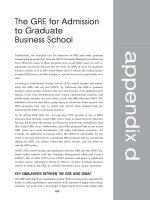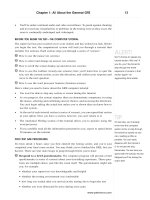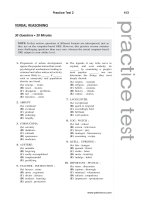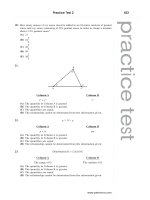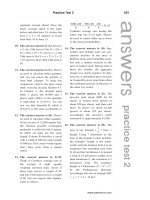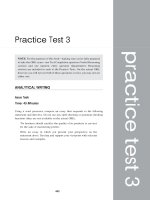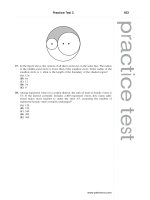Tài liệu Master the Gre 2010 - Part 24 pptx
Bạn đang xem bản rút gọn của tài liệu. Xem và tải ngay bản đầy đủ của tài liệu tại đây (56.15 KB, 10 trang )
GEOMETRIC SEQUENCES
In a geometric sequence of numbers, each term is a constant multiple of the preceding
one; in other words, the ratio between any term and the next one is constant. The
multiple (or ratio) might be obvious by examining the sequence. For example:
In the geometric sequence 2, 4, 8, 16, ,youcaneasily see that the
constant multiple is 2 (and the ratio of each term to the next is 1:2).
In the geometric sequence 1, 23, 9, 227, ,youcaneasily see that the
constant multiple is 23 (and the ratio of each term to the next is 1:23).
Once you know the multiple (or ratio), you can answer any question asking for an
unknown term—or for either the sum or the average of certain terms.
25. In a geometric sequence, each term is a constant multiple of the preceding
one. If the third and fourth numbers in the sequence are 8 and 216,
respectively, what is the first term in the sequence?
(A) 232
(B) 24
(C) 2
(D) 4
(E) 64
The correct answer is (C). The constant multiple is 22. But since you need to
work backward from the third term (8), apply the reciprocal of that multiple
twice. The second term is ~8!
S
2
1
2
D
524. The first term is ~24!
S
2
1
2
D
5 2.
26. In a geometric sequence, each term is a constant multiple of the preceding
one. What is the sum of the first four numbers in a geometric sequence
whose second number is 4 and whose third number is 6?
(A) 16
(B) 19
(C)
22
1
2
(D)
21
2
3
(E) 20
The correct answer is (D). The constant multiple is
3
2
. In other words, the ratio
of each term to the next is 2:3. Since the second term is 4, the first term is 4 3
2
3
5
8
3
. Since the third term is 6, the fourth term is 6 3
3
2
5
18
2
, or 9. The sum of
the four terms 5
8
3
1 4 1 6 1 9 5 21
2
3
.
You can also solve geometric sequence problems by applying a special formula. But
you’ll need to memorize it because the test won’t provide it. In the following formula,
Chapter 9: Math Review: Number Forms, Relationships, and Sets 213
ALERT!
You can’t calculate the
average of terms in a
geometric sequence by
averaging the first and last
term i n the sequence: The
progression is geometric, not
arithmetic. You need to add
up the terms, then divide by
the number of terms.
www.petersons.com
r 5 the constant multiple (or the ratio between each term and the preceding one), a 5
the first term in the sequence, n 5 the position number for any particular term in the
sequence, and T 5 the particular term itself:
ar
(n 2 1)
5 T
You can solve for any of the formula’s variables, as long as you know the values for
the other three. Following are two examples:
If a 5 3 and r 5 2, then the third term 5 (3)(2)
2
5 12, and the sixth term 5 (3)(2)
5
5 (3)(32) 5 96.
If the sixth term is 2
1
16
and the constant ratio is
1
2
, then the first term (a) 522:
a
S
1
2
D
5
5
2
1
16
a
S
1
32
D
5
2
1
16
a 5
S
2
1
16
D
~32!
522
The algebra is simple enough—but you need to know the formula, of course.
27. In a geometric sequence, each term is a constant multiple of the preceding
one. If the first three terms in a geometric sequence are 22, x, and 28,
which of the following could be the sixth term in the sequence?
(A) 232
(B) 216
(C) 16
(D) 32
(E) 64
The correct answer is (E). Since all pairs of successive terms must have the
same ratio,
22
x
5
x
28
. By the cross-product method, x
2
5 16, and hence x 564.
For x = 4, the ratio is
4
22
522. Applying the formula you just learned, the sixth
term would be (22)(22)
5
5 64. For x 524, the ratio is
24
22
5 2. The sixth term
would be (22)(2)
5
5264.
PERMUTATIONS
A permutation is an arrangement of objects in which the order (sequence) is
important. Each arrangement of the letters A, B, C, and D, for example, is a different
permutation of the four letters. There are two different ways to determine the number
of permutations for a group of distinct objects.
PART IV: Quantitative Reasoning214
www.petersons.com
List all the permutations, using a methodical process to make sure you don’t
overlook any. For the letters A, B, C, and D, start with A in the first position, then
list all possibilities for the second position, along with all possibilities for the third
and fourth positions (you’ll discover six permutations):
A B CD AC BD AD BC
A B DC AC DB AD CB
Placing B in the first position would also result in 6 permutations. The same
applies to either C or D in the first position. So, the total number of permuta-
tions is 6 3 4 5 24.
Use the following formula (let n 5 the number of objects) and limit the number of
terms to the counting numbers, or positive integers:
Number of permutations 5 n(n 2 1)(n 2 2)(n 2 3) (1).
The number of permutations can be expressed as n!(“n” factorial). Using the
factorial is much easier than compiling a list of permutations. For example, here’s
how to determine the number of arrangements (permutations) of the four letters
A, B, C, and D: 4! 5 4(4 2 1)(4 2 2)(4 2 3) 5 4 3 3 3 2 3 1 5 24.
28. Five tokens—one red, one blue, one green, and two white—are arranged in
a row, one next to another. If the two white tokens are next to each other,
how many arrangements according to color are possible?
(A) 12
(B) 16
(C) 20
(D) 24
(E) 30
The correct answer is (D). The two white tokens might be in positions 1 and 2,
2 and 3, 3 and 4, or 4 and 5. For each of these four possibilities, there are 6
possible color arrangements (3!) for the other three tokens (which all differ in
color). Thus, the total number of possible arrangements is 4 3 6, or 24.
COMBINATIONS
A combination is a group of certain objects selected from a larger set. The order of
objects in the group is not important. You can determine the total number of possible
combinations by listing the possible groups in a methodical manner. For instance, to
determine the number of possible three-letter groups among the letters A, B, C, D,
and E, work methodically, starting with A as a group member paired with B, then C,
then D, then E. Be sure not to repeat combinations (repetitions are indicated in
parentheses here):
Chapter 9: Math Review: Number Forms, Relationships, and Sets 215
TIP
You can shortcut common
factorial calculations by
memorizing them: 3! 5 6, 4! 5
24, and 5! 5 120.
ALERT!
Notice that each
parenthetical combination
backtracks to an earlier letter.
Be sure you don’t repeat any
combination and make sure
you don’t backtrack to an
earlier object.
www.petersons.com
A, B, C (A, C, B) (A, D, B) (A, E, B)
A, B, D A, C, D (A, D, C) (A, E, C)
A, B, E A, C, E A, D, E (A, E, D)
Perform the same task assuming B is in the group, then assuming C is in the group
(all combinations not listed here repeat what’s already listed).
B, C, D
B, C, E
B, D, E
C, D, E
The total number of combinations is 10.
29. How many two-digit numbers can be formed from the digits 1 through 9, if
no digit appears twice in a number?
(A) 36
(B) 72
(C) 81
(D) 144
(E) 162
The correct answer is (B). Each digit can be paired with any of the other 8
digits. To avoid double counting, account for the possible pairs as follows: 1 and
2–9 (8 pairs), 2 and 3–9 (7 pairs), 3 and 4–9 (6 pairs), and so forth. The total
number of distinct pairs is 8 1 7 1 6 1 5 1 4 1 3 1 2 1 1 5 36. Since the digits
in each pair can appear in either order, the total number of possible two-digit
numbers is 2 3 36, or 72.
Here’s something to consider: You can approach combination problems as probability
problems as well. Think of the “probability” of any single combination as “one divided
by” the total number of combinations (a fraction between zero (0) and 1). Use
whichever method is quickest for the question at hand.
PROBABILITY
Probability refers to the statistical chances of an event occurring or not occurring. By
definition, probability ranges from zero (0) to 1. (Probability is never negative, and it’s
never greater than 1.) Here’s the basic formula for determining probability:
Probability 5
number of ways the event can occur
total number of possible occurrences
PART IV: Quantitative Reasoning216
www.petersons.com
30. If you randomly select one candy from a jar containing two cherry
candies, two licorice candies, and one peppermint candy, what is the
probability of selecting a cherry candy?
(A)
1
6
(B)
1
5
(C)
1
3
(D)
2
5
(E)
3
5
The correct answer is (D). There are two ways among five possible
occurrences that a cherry candy will be selected. Thus, the probability of
selecting a cherry candy is
2
5
.
To calculate the probability of an event not occurring, just subtract the probability of
the event occurring from 1. So, referring to the preceding question, the probability of
not selecting a cherry candy is
3
5
. (Subtract
2
5
from 1.)
On the GRE, a tougher probability question would involve this basic formula, but it
would also add a complication of some kind. It might require you to determine any of
the following:
• certain missing facts needed for a given probability
• probabilities involving two (or more) independent events
• probabilities involving an event that is dependent on another event
For these three types of probability questions, which we’ll examine next, don’t try to
“intuit” the answer. Probabilities involving complex scenarios such as these are often
greater or less than you might expect.
Missing Facts Needed for a Given Probability
In this question type, instead of calculating probability, you determine what missing
number is needed for a given probability. To do so, just plug what you know into the
basic formula and solve for the missing number.
31. A piggy bank contains a certain number of coins, of which 53 are dimes
and 19 are nickels. The remainder of the coins in the bank are quarters. If
the probability of selecting a quarter from this bank is
1
4
, how many
quarters does the bank contain?
(A) 30
(B) 27
(C) 24
(D) 21
(E) 18
The correct answer is (C). On its face, this question looks complicated, but it’s
really not. Just plug what you know into the probability formula. Let x 5 the
number of quarters in the bank (this is the numerator of the formula’s fraction),
Chapter 9: Math Review: Number Forms, Relationships, and Sets 217
TIP
The probability of an event not
occurring is 1 minus the
probability that it will occur.
www.petersons.com
and let x 1 72 5 the total number of coins (the fraction’s denominator). Then
solve for x (use the cross-product method to clear fractions):
1
4
5
x
x 1 72
x 1 72 5 4x
72 5 3x
24 5 x
Probability Involving Two or More Independent Events
Two events are independent if neither event affects the probability that the other will
occur. (You’ll look at dependent events next.) On the GRE, look for either of these two
scenarios involving independent events:
The random selection of one object from each of two or more groups
The random selection of one object from a group, then replacing it and selecting
again (as in a “second round” or “another turn” of a game)
In either scenario, the simplest calculation involves finding the probability of two
events both occurring. All you need to do is multiply together their individual prob-
abilities: (probability of event 1 occurring) 3 (probability of event 2 occurring) 5
(probability of both events occurring).
For example, assume that you randomly select one letter from each of two sets: {A,B}
and {C,D,E}. The probability of selecting A and C 5
1
2
3
1
3
,or
1
6
.
To determine the probability that three events will all occur, just multiply the third
event’s probability by the other two. To calculate the probability that two events will
not both occur, subtract from 1 the probability of both events occurring.
32. From a group of seven students, one student is called on at random to
answer a question. Then one of the same seven students is called on at
random to answer another question. What is the probability that the
same student will NOT be called on to answer BOTH questions?
(A)
1
14
(B)
1
2
(C)
6
7
(D)
13
14
(E)
48
49
The correct answer is (E). You must first calculate the chances of
picking a particular student twice by multiplying together the two
individual probabilities for the student:
1
7
3
1
7
5
1
49
. The probability of not
picking the same student twice is 1 2
1
49
=
48
49
.
PART IV: Quantitative Reasoning218
www.petersons.com
Probability Involving a Dependent Event
Two distinct events might be related in that one event affects the probability of the
other one occurring—for example, randomly selecting one object from a group, then
selecting a second object from the same group without replacing the first selection.
Removing one object from the group increases the odds of selecting any particular
object from those that remain.
You handle this type of problem as you would any other probability problem: Cal-
culate individual probabilities, then combine them.
33. In a random selection of two people from a group of five—A, B, C, D,
and E—what is the probability of selecting A and B?
(A)
2
5
(B)
1
5
(C)
1
10
(D)
1
15
(E)
1
20
The correct answer is (C). You need to consider each of the two
selections separately. In the first selection, the probability of selecting
either A or B is
2
5
. But the probability of selecting the second of the two is
1
4
, because after the first selection only four people remain from whom to
select. Since the question asks for the probability of selecting both A and B
(as opposed to either one), multiply the two individual probabilities:
2
5
3
1
4
5
2
20
5
1
10
.
You can also approach probability problems like Question 33 (above) as combination
problems. For Question 33, here are all the combinations:
• A and either B, C, D, or E (4 combinations)
• B and either C, D, or E (3 combinations)
• C and either D or E (2 combinations)
• D and E (1 combination)
There are 10 possible combinations, so the probability of selecting A and B is 1 in 10.
Chapter 9: Math Review: Number Forms, Relationships, and Sets 219
ALERT!
Strategies such as plugging in
test numbers, working
backward, and sizing up
answer choices don’t work for
most probability questions.
www.petersons.com
SUMMING IT UP
• Although the types of questions reviewed in the early sections of this chapter are
the most basic of the math problems you’ll encounter on the GRE Quantitative
Reasoning section, don’t underestimate how useful they’ll be as building blocks
for solving more complex problems.
• Certain fraction-decimal-percent equivalents show up more frequently than
others on the GRE. If you have time, memorize the standard conversions to save
yourself time on the actual exam.
• Percent change questions are typical on the GRE Quantitative Reasoning section,
so be ready for them.
• As with fractions, you can simplify ratios by dividing common factors.
• Review the definitions of arithmetic mean, median, mode, and range, so you’re
better equipped to solve such problems on the exam.
• Many arithmetic sequence questions ask for the average or sum of a sequence.
You may be able to “shortcut” the addition instead of calculating the average of a
long sequence of evenly spaced integers.
• Memorizing common factorial combinations will save you time when you
encounter permutation questions on the GRE.
• Work methodically on combination questions to avoid backtracking to an earlier
object.
• It’s wise not to try “intuiting” the answers to probability questions. Many of these
problems are too complex to arrive at an accurate answer this way.
PART IV: Quantitative Reasoning220
www.petersons.com
Math Review: Number
Theory and Algebra
OVERVIEW
• Basic properties of numbers
• Factors, multiples, and divisibility
• Prime numbers and prime factorization
• Exponents (powers)
• Roots and radicals
• Linear equations with one variable
• Linear equations with two variables
• Simple algebraic functions
• Linear equations that cannot be solved
• Factorable quadratic expressions with one variable
• Nonlinear equations with two variables
• Solving algebraic inequalities
• Solving algebra “story” problems
• Summing it up
In this chapter, you’ll first broaden your arithmetical horizons by dealing with
numbers in more abstract, theoretical settings. You’ll examine the following
topics:
• The concept of absolute value
• Number signs and integers—and what happens to them when you apply
the four basic operations
• Factors, multiples, divisibility, prime numbers, and the “prime factor-
ization” method
• The rules for combining exponential numbers (base numbers and
“powers”) using the four basic operations
• The rules for combining radicals using the four basic operations
• The rules for simplifying terms containing radical signs
Then you’ll review the following basic algebra skills:
• Solving a linear equation with one variable
chapter 10
221
• Solving a system of two equations with two variables—by substitution and by
addition-subtraction
• Recognizing unsolvable linear equations when you see them
• Applying simple algebraic functions
• Handling algebraic inequalities
Later you’ll learn how the GRE tests your algebra skills through the use of “story”
problems, which involve real-world scenarios.
BASIC PROPERTIES OF NUMBERS
First let’s review the basics about integers, number signs (positive and negative), and
prime numbers. Make sure you’re up to speed on the following definitions, which
you’ll need to know for this chapter as well as for the test:
• Absolute value (of a real number): The number’s distance from zero (the
origin) on the real number line. The absolute value of x is indicated as |x|.By
definition, a number’s absolute value cannot be negative—that is, less than
zero (0).
• Integer: Any non-fraction number on the number line: {. . . 23, 22, 21, 0, 1, 2,
3 . }.Exceptfor the numberzero (0), every integer iseither positive or negative and
either even or odd.
• Factor (of an integer n): Any integer that you can multiply by another integer
for a product of n.
• Prime number: Any positive integer greater than one that has exactly two
positive factors: 1 and the number itself. In other words, a prime number is not
divisible by (a multiple of) any positive integer other than itself and 1.
Number Signs and the Four Basic Operations
The four basic operations are addition, subtraction, multiplication, and division. Be
sure you know the sign of a number that results from combining numbers using these
operations. Here’s a table that includes all the possibilities (a “?” indicates that the
sign depends on which number has the greater absolute value):
Addition Subtraction Multiplication Division
~1!1~1!51
~2! 1 ~2! 5 2
~1! 1 ~2! 5 ?
~2! 1 ~1! 5 ?
~1! 2 ~2! 5 ~1!
~2!2~1!5~2!
~1!2~1!5?
~2! 2 ~2! 5 ?
~1! 3 ~1! 5 1
~1!3~2!52
~2! 3 ~1! 5 2
~2!3~2!51
~1!4~1!51
~1!4~2!52
~2!4~1!52
~2!4~2!51
GRE problems involving combining numbers by addition or subtraction usually incor-
porate the concept of absolute value, as well as the rule for subtracting negative
numbers.
PART IV: Quantitative Reasoning222
ALERT!
The factors of any integer n
include 1 as well as n itself.
Zero (0) and 1 are not prime
numbers; 2 is the first prime
number.
www.petersons.com
